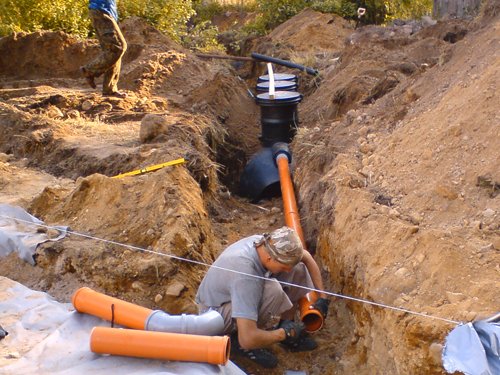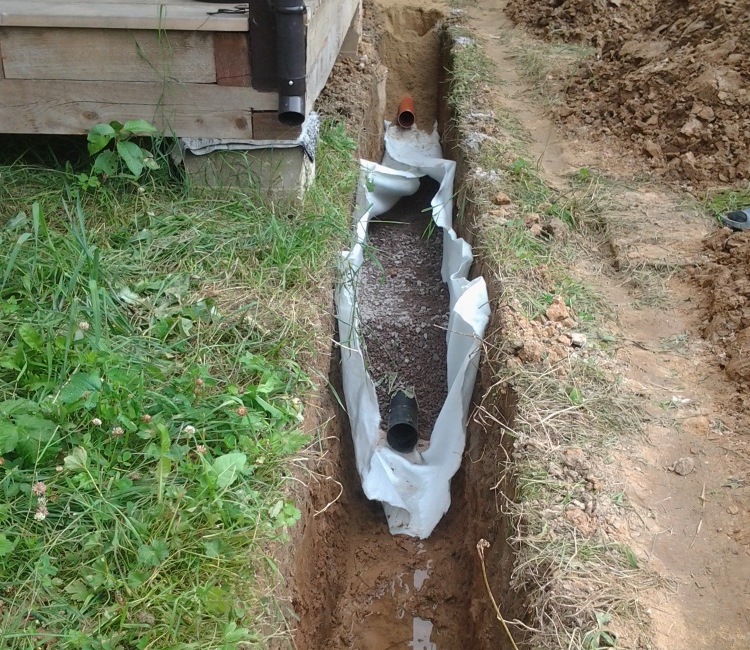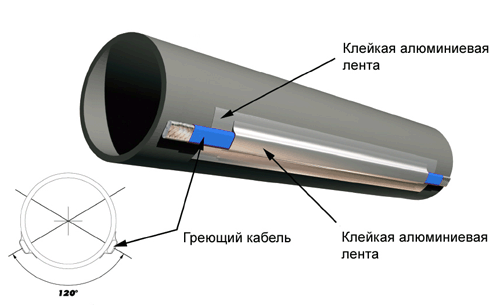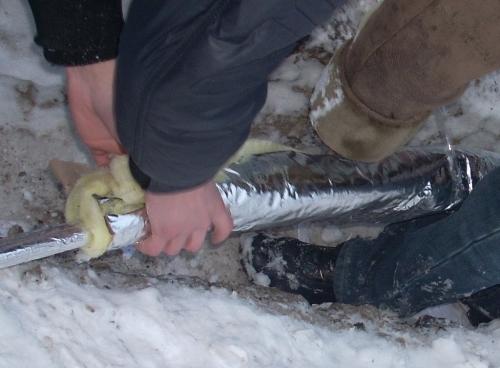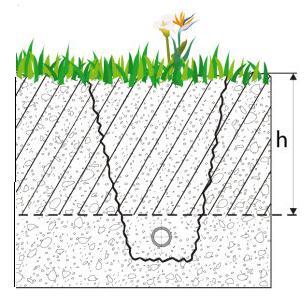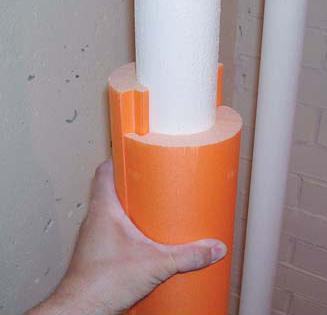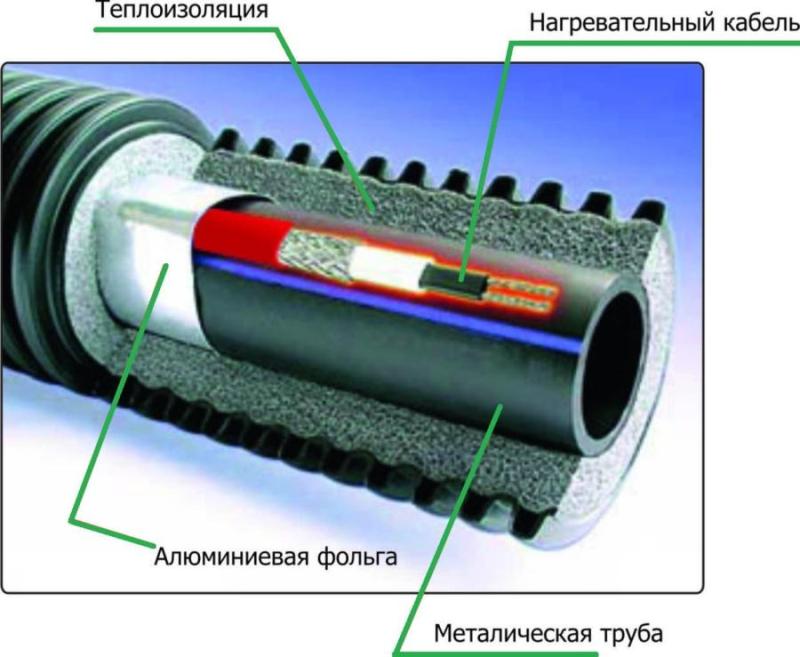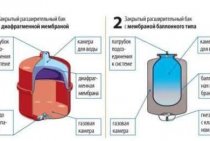Bury pipes deep in the ground
The most reliable way of warming is to deepen them into the ground. The deeper the pipe is, the less likely it is to freeze. Indeed, at a certain depth, the temperature does not change even in winter.
How to determine the optimal depth for laying pipes? It is impossible to give universal advice for every locality. In each climatic zone, the soil freezes to a different thickness. In some areas, it is enough to bury to a meter depth. In others, the ground can freeze up to two meters. Having coped with the climatic atlas of your area and determining the depth of freezing, you will be able to carry out earthworks correctly. True, the builders are advised to put on a stock and go a little deeper.
Burying pipes deep into the ground is a good option. However, in practice, this effective and low-cost method of insulation is not always used. Why? Earthworks cause complications even in cases where pipes should be buried to a meter depth. If you need to dig deeper, there is a desire to come up with another way to insulate the sewer pipe. In addition, sites are often located in areas where excavation is either impossible or very expensive.
By digging deep, you will create another problem. Suppose there is a problem with the system. You are not even sure if there is a leak, but you need to check the pipe. And for this you will have to turn over the mountains of soil again, inspect, look for damage and bury them back. And if you need to replace one or more sections?
good or bad
The high price of a heat-insulating material does not always indicate its remarkable properties. There are unscrupulous manufacturers, among the sellers there are lovers of "wind up" the price. Before you choose and buy a heater, you need to study its characteristics well and think it over carefully. It is very good if you can get a sample and do some experiments:
- Bring a small piece of heat-insulating material to a bright lamp. Shines through - bad. If the insulation for sewer pipes transmits light, heat will also pass through it. This check is not necessary for additionally coated materials (foiled and similar).
- When it comes to foam, you need to look at the cut. Air cells should be small, ideally approximately the same. Large air chambers will not retain heat well.
- Ignite the sample. High-quality insulation does not burn. Some materials for heat insulators initially have flammability, which is eliminated with the help of special additives.
- Try to pull, tear a fragment of the heat insulator. If this happened very easily, the strength is in doubt. Such material can simply be accidentally damaged during the installation process.
Such a comprehensive check will help you make the final choice.
Insulation for sewer pipes
Since we are talking about the insulation of the external sewer system in a private house, we will consider how to insulate pipes with our own hands
The most important thing in the process of insulating external sewerage is the choice of material that will determine the installation features and provide a given level of heat loss reduction.
It should be noted that sewer insulation, as a separate type, is a non-existent material. Those. there is no single solution, and in each case it is necessary to select a heater based on the individual characteristics of the pipeline.
Thermal insulation of sewer pipes is carried out by any of the thermal insulation materials on the market.
There are only two determining factors when choosing a heater:
climatic zone. The lower the winter temperature, the lower the thermal conductivity of the insulation should be;
pipe laying method. The choice of pipe insulation depends on how deep the pipes are laid (below or above the freezing level). The technology for insulating external sewage using thermal insulation comes down to two methods: the pipe is wrapped with insulation in several layers or a box is built around it.
What insulation for sewer pipes is better to choose?
A good building heat insulator must meet a number of requirements:
- low coefficient of thermal conductivity;
- ease of installation;
- resistance to various factors: moisture, biological activity, ultraviolet, mechanical or chemical impact;
- tightness of insulation;
- use resource;
- price.
Sewer insulation methods
Consider several ways to insulate the sewer, which will save your money and will not take much effort during installation.
There are also a few more easy ways to insulate sewer pipes.
Method one
The easiest way, as it seemed, is to bury the pipes below the freezing level of the soil. But, taking into account that, depending on the continental location, each city and suburb has its own level of soil freezing.
Burying pipes below freezing ground is one of the simplest ways. Click to enlarge.
And you will be lucky if on your site it will be no more than a meter.
Then there are many more factors for which this method of protecting sewer pipes may not be available.
The main factor includes the structural features of the soil, proximity to groundwater, the presence of harmful substances and insects that destroy the structure of pipes. Therefore, such insulation of sewer pipes may not be possible.
It is also worth taking into account the repair in the event of a pipe break. It is not necessary that the water supply can freeze, there are a lot of influences, the results of which lead to malfunctions in any section of the laid pipe.
It is not necessary that the water supply can freeze, there are a lot of influences, the results of which lead to malfunctions in any section of the laid pipe.
And in order to repair the damaged area, you will have to dig out the pipe again, and for good, if it is noticeable where the breakdown occurred, and if not, then dig it out completely, and in this case you will have to change it.
So this method, although it will cost you inexpensively, is not practical.
Second way
The second method involves the insulation of sewer pipes by laying an electrical cable. This method is quite reliable, and applies not only to external insulation, but also in houses with a poor heating system.
And the main one is complete dependence on the power supply.
That is, if your electricity was turned off for some reason, then you will not receive pipe heating.
The second drawback is the inspiring bills for paying for electricity consumption. And if something burns out there, breaks the pipe, this can lead to a short circuit, or, even worse, a fire.
Third way
How to insulate the sewer so that it is not resource-intensive and safe, then a method is proposed that involves the use of appropriate insulating materials.
Before buying such materials, you should pay attention to important properties:
- Durability
- Moisture proof
- Ease of installation
- Flammability
- Material cost
It is also worth considering the characteristics of the insulation material and the possibility of reuse.
Ways to fight
You can avoid emergencies and prevent freezing of sewer pipes in the ground using the following tips:
The laying of the pipeline for sewerage must be carried out to a certain depth. It is recommended to place it below the freezing level. The fact is that the temperature indicators at this level do not fall below 1-2 ° C.This indicator is optimal, and allows you to carry out work without the use of insulating materials. If the work is performed by non-professionals, then this rule is not respected. Pipes are laid above the freezing level, which can create an unusual situation during severe frosts and lead to a breakthrough. This method of deepening is needed when sewer insulation is carried out in a private house, and the owners do not live here permanently.
Special materials designed for thermal insulation should be used. Pipes are carefully covered with a material with high thermal insulation properties. It slows down the cooling process and the outflow of heat. Pipes are also heated with an electric cable specially designed for this purpose. If it is necessary to insulate a device that is subject to freezing, then the slope of the pipes is performed. It is at least 2 cm per meter. At the same time, an electric cable is laid outside the pipe, which performs the functions of a heater. In its absence, the pipes freeze through, and the frozen water in them forms ice jams.
As a result, the sewer system fails.
It is important to properly insulate the ventilation pipes. They are located outside, and are brought to the surface of the roof from the sewer riser.
Some of them come from underground and serve to ventilate a septic tank or sewer tanks. When the effluents evaporate, they settle on the inner sides of the pipes. Over time, they freeze and fill the entire system. Residents begin to smell the stench due to a failed ventilation system. The situation can be corrected by pouring a bucket of water into a frozen riser. Only after that it should be insulated. If an electric cable is used for insulation, then it must be packed in a corrugation. A plastic container will do as well. This will ensure the longevity of the ventilation system.
Installation of insulation of sewer communications in the ground
The insulation is laid when all the pipes have already been laid and connected to the sewer itself.
In this case, all pipes go under a slope of 1 centimeter per linear meter.
When installing the insulation, you should pay special attention to ensuring that there are no bare areas left, otherwise this whole procedure will be useless. Also, the beginning and end of the pipe, joints are especially carefully processed.
In such places, you can put several layers of insulation to be sure.
Also, the beginning and end of the pipe, the joints are especially carefully processed. In such places, you can put several layers of insulation to be sure.
The rest of the installation of insulation is very simple and takes little time.
Mounting Features
Having chosen the desired insulation, immediately read the instructions for it, as each of them has its own characteristics.
If you are additionally doing waterproofing, then you should immediately calculate how much material you will need.
At pipe bends, more thorough insulation and waterproofing should be done, any of the above materials is suitable for this. Thanks to their convenient cylindrical shape and plasticity, they will be able to repeat any bend without breaking.
You can additionally insulate sewer pipes using a heating cable for pipes. It maintains the temperature of the pipe well, preventing it from freezing.
The cable can be an independent insulation, but most often it is wrapped on top with another layer of any insulation.
You can see an approximate scheme of insulation with a heating cable in the figure below.
Heating cable insulation
This cable gives almost 100% guarantee that the pipe will not freeze under any conditions.
Installation rules
Warming with the selected material is carried out before filling the pipe with earth, while all the edges of the pipes and seals must be sealed with a sealant so that moisture from the pipes does not spoil the material.
If you chose foam shells for insulation, then you just need to put them on the pipe and fix them additionally with an aluminum self-adhesive tape.
If it is mineral wool or basalt fiber, then they must be laid with the foil side out, as shown in the photo below.
Installation of glass wool with waterproofing
In this case, all joints must be glued with construction tape very carefully so that there is no access to moisture.
Also, pipes are insulated only in dry weather, dirt and other debris must be removed from them so that nothing prevents the insulation from joining the pipe tightly.
How to protect sewer pipes from freezing
- engineering;
- with the help of a heater;
- active.
engineering method
The engineering method is the simplest solution to the question of how to insulate sewer pipes on the street. It consists in the following - the pipes are simply laid below the level of soil freezing. As practice shows, for this they sometimes have to be laid to a depth of 2 m or more. For each region, depending on the climate, the depth of the bookmark will be different. Implement this method as follows:
- At a given depth, they dig a trench under the drain pipeline with a slope of 1 cm per meter of its length. The depth can be found in a special table for each region.
- At the bottom of the dug trench, a sand cushion or a cushion of fine gravel (grain size no more than 20 mm) is made, at least 10 cm thick.
- Lay pipes.
- Cover them with a layer of sand or fine gravel. The layer should be located above the pipe at a height of at least 20 cm and be carefully compacted.
- Fill the trench with previously excavated soil.
Scheme of laying a sewer pipe below the freezing level
Thermal insulation method
What insulation to use - indicated above. The choice of material depends on many factors, among which, first of all, one should highlight the cost and thermal insulation properties.
So, let's consider how to properly insulate a sewer pipe. Installation of an external drain system using heat-insulating material must be carried out in the following sequence:
- The place where the trench will pass is marked.
- A trench is being dug, while its width should be at least 60 cm, and the depth should correspond to the project data with a margin of 5–10 cm. The trench is equipped with a mandatory slope (1 cm per 1 running meter) to ensure gravity flow.
- At the bottom of the trench, sand or gravel with a thickness of at least 10 cm is poured and rammed.
- The pipeline is assembled on the surface next to the trench.
- The seal and the edge of the pipe must be lubricated with sealant.
- The insulation is put on the pipe and fixed (usually with adhesive tape) so that it does not move.
- The pipe is lowered into a trench, covered with a layer of sand or gravel, after which it is rammed.
- Next, the trench is finally covered with soil, while making sure that it does not contain stones, broken glass or hard soil.
Internal sewerage, as a rule, is not insulated. Only the exit of the riser to the roof of the house is subject to thermal insulation, since with a sharp temperature drop it can simply burst. The material for insulation of the riser can also be either mineral wool or expanded polystyrene.
Heat-insulating shell for external sewage pipes
active way
The most costly way of thermal insulation is the so-called active insulation. It consists in laying electric heating cables along pipes. These cables, when heated, give off heat to the pipeline and prevent it from freezing. The heating system is controlled by a temperature sensor with automation connected to it. As soon as the temperature around the external sewer system approaches zero, the sensor is triggered and the cable heats up the pipeline. When the ground temperature rises, the system automatically turns off.
Applying active insulation in practice, you will also need to arrange an insulation system, because. the heating cable will heat the ground, not the pipes. This method is quite costly both during implementation and during operation, and not everyone can afford it.
How to insulate a drain pipe facing the street? The simplest and cheapest method is a foam shell, which will insulate it well. In everyday life, glass wool is more often used, which is simply wrapped around the drain pipe and tied with tape.
Scheme of heating a sewer pipe with a heating cable
Insulated outdoor sewer pipes will last longer if one of the thermal insulation methods described above is implemented. In addition, when laying the system, it is recommended to use smooth pipes made of polyvinyl chloride and polypropylene with an orange surface.
Insulation of the hood for sewage background riser
Separately, it should be noted the need for insulation of external sewerage, which is understood as a ventilated background riser (hood) - a sewer pipe brought to the roof (or to the surface of the earth from a septic tank) and providing pipeline ventilation.
The background riser is designed to suck in air so that the pressure in the system is equalized when the toilet is flushed. And in the septic tank from the vital activity of bacteria, gases are formed, which are also removed through the background pipe.
The ventilation (background) pipe can freeze (condensate freezes and an ice plug forms) and needs to be insulated. Any material that is reliably protected from moisture and destruction by ultraviolet radiation is suitable for thermal insulation. For example, you can put a “stocking” Stenoflex on the pipe. The part of the pipe that is above the roof is insulated. And you can’t put a cap on top of the pipe, it must be free, otherwise it will freeze in this place.
How to insulate the background riser with your own hands
On the forum, one user suggested an interesting way to get rid of the buildup (freezing) of condensate in the background pipe.
You need to take a copper wire (necessarily from pure copper, without a braid, this is important), wind it into a voluminous, but at the same time “liquid” lump (so that air can easily pass through it). Push this wire ball from above into the pipe, and bend the ends of the wire so that you can fix the wire at the top of the pipe (otherwise it will fall inside)
Push this wire ball from above into the pipe, and bend the ends of the wire so that you can fix the wire at the top of the pipe (otherwise it will fall inside).
The meaning lies in the chemical properties of copper, it has a very high thermal conductivity. Warm air rises through the pipe, copper accumulates heat and melts the freezing condensate.
Conclusion
Sewer insulation in a private house is an important measure that will maintain the normal patency of sewer pipes in winter, prevent freezing of the pipeline and extend its service life.
Pipeline laying below freezing depth
During the laying of the sewage system on your own, you can try to lay the parts to a depth that will be 10 centimeters lower than the level of soil freezing. With this arrangement, additional thermal insulation of sewer pipes is not required. Naturally, this is considered an ideal option, but it is used extremely rarely.
Causes:
- The presence of a large amount of work that will have to be carried out
when preparing a trench for laying, as well as for digging a hole for a septic tank. If not
special equipment is involved, then with your own hands to make such a volume
extremely difficult. - Under the conditions of the middle lane, the depth of soil freezing
is one and a half meters. It turns out that the pipes will have to be laid to a depth
1.6 m. In addition, the pipeline must be laid with a slope, so the septic tank
it is necessary to lay at a depth of two and a half or three meters.
The use of such a laying of the sewage system is irrational. - When sewer pipes are too deep, carry out
repair of the drain, especially in winter, will be impossible.
It turns out that the choice of the option of deepening below the level of freezing
soil can be selected only when it is possible to work
attract special equipment.
